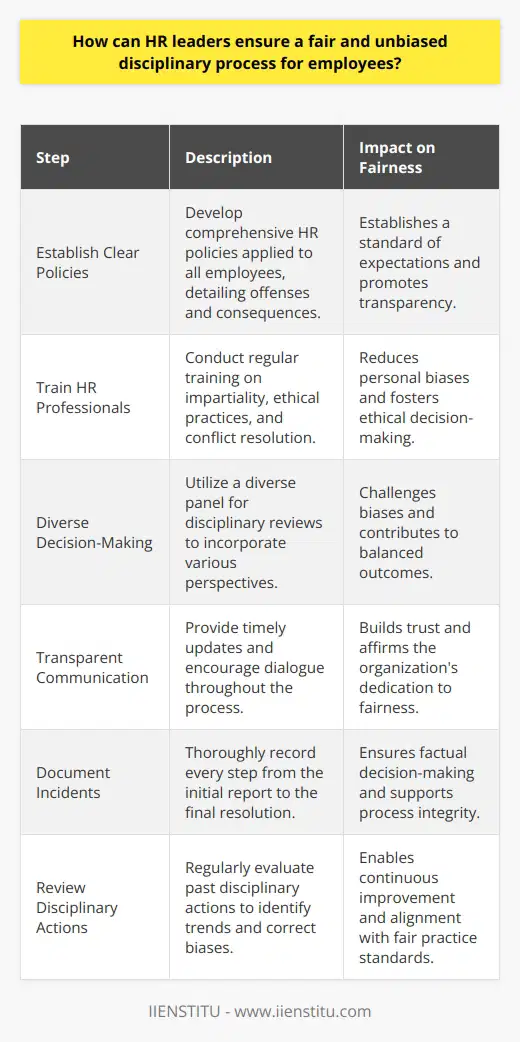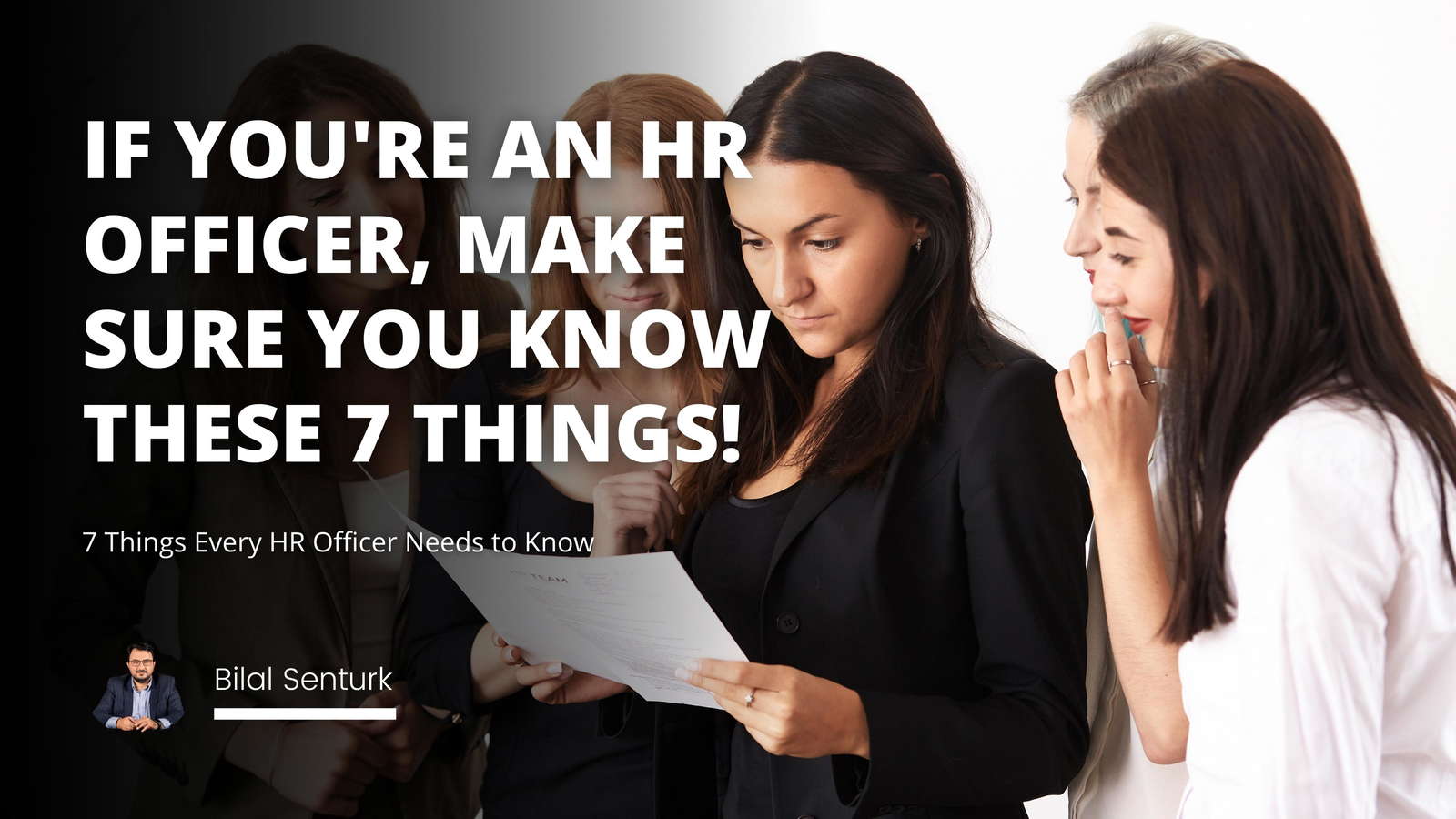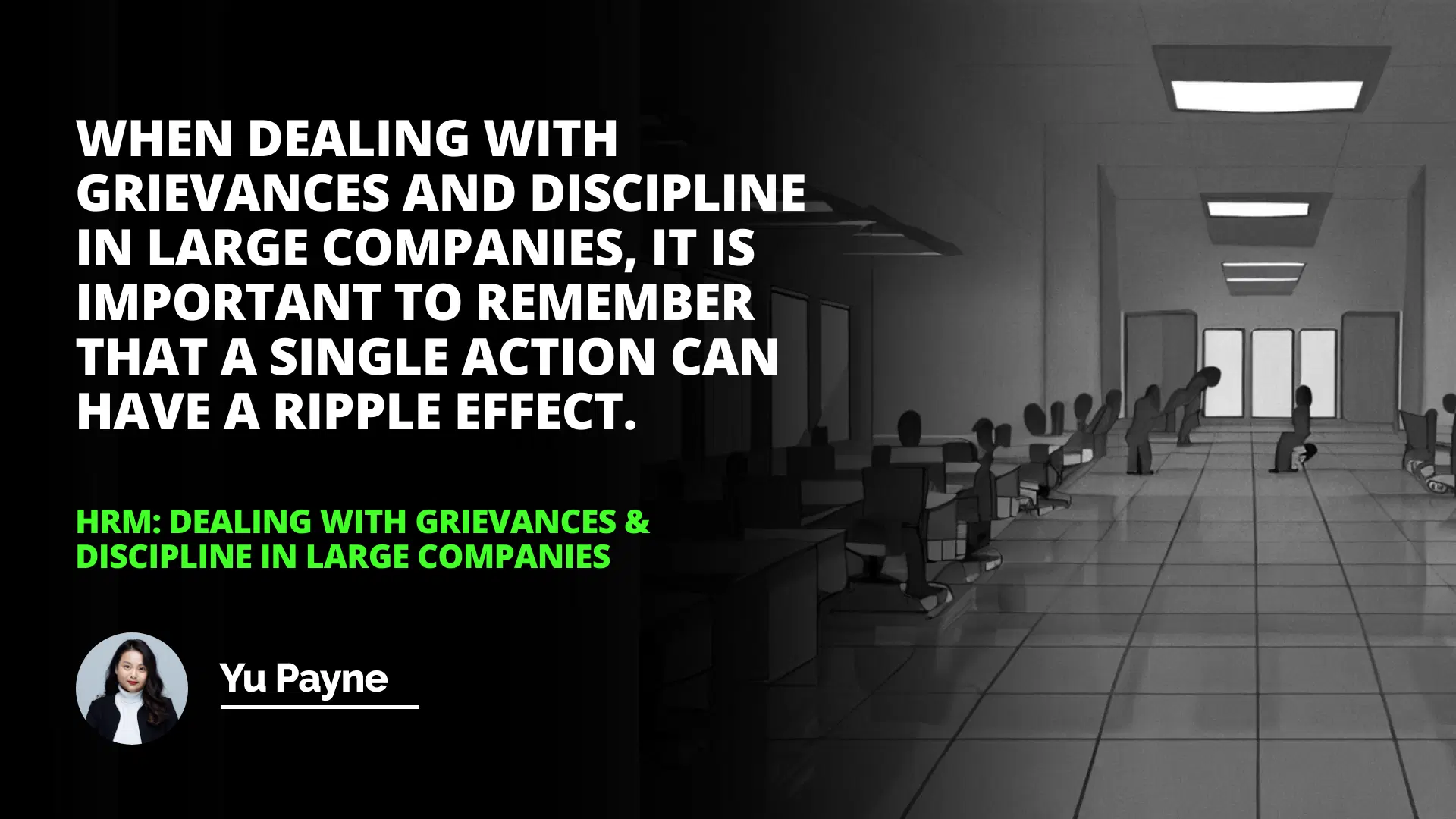
Unions can complicate the process, and effective communication is critical to ensuring that all employees know the rules and the consequences of violating them. Open communication is also essential to deal with grievances and disciplinary issues, as it can help prevent grievances from occurring in the first place.
This article discusses grievances and disciplinary problems in large companies and the complications of unions. It explains the importance of effective communication in communicating acceptable and unacceptable behavior, as well as the importance of open communication in dealing with grievances.
It emphasizes that open communication is essential to preventing grievances from occurring in the first place. That managing grievances and disciplinary problems in large organizations can be complex and challenging.
Introduction
Grievances & Discipline in Large Companies
Unions & Complications
Communicating Acceptable & Unacceptable Behavior
Open Communication & Grievances
Introduction: Grievances and disciplinary problems in large organizations can be complex and challenging. In addition to the need for more steps and the involvement of more people, the list of infractions leading to disciplinary action is usually longer in large companies than in small ones.
And if unions are involved, matters become that much more complicated. This article will discuss grievances and disciplinary problems in large companies, the complications posed by unions, communicating acceptable and unacceptable behavior, and the importance of open communication in dealing with grievances.
Grievances & Discipline in Large Companies
Grievances and disciplinary problems in large companies are often more challenging to manage than in small companies. This is due to the more significant number of employees, the long list of infractions, and the more substantial number of reporting levels. This can make it difficult for management to ensure that all employees know company procedures and the consequences of violating them. Furthermore, the bigger the company, the poorer the lines of communication tend to be. This can lead to employees being verbally warned or written up for violating rules they were unaware of.
Unions & Complications
When unions are involved in grievances and disciplinary problems in large organizations, matters become even more complicated. Partnerships can help protect employees from unfair treatment, but they can also complicate dealing with grievances and disciplinary issues. For example, unions may require that specific steps be taken before disciplinary action or procedures be followed when dealing with grievances. This can slow down the process and make it more difficult for management to take swift action.
Benefits Administration: Comprehensive Insights and Best Practices
Variable Pay: An In-depth Look at Modern Compensation Strategies
Communicating Acceptable & Unacceptable Behavior
Large companies must ensure that all employees know company procedures and the consequences of violating them. This can be accomplished through effective communication. Management should ensure that all employees are aware of the rules and regulations of the company, as well as the consequences of violating them. This can be done through regular meetings, training sessions, and even emails. This will help ensure that all employees are on the same page and understand what is expected of them.
Open Communication & Grievances
Open communication is essential when dealing with grievances and disciplinary problems in large companies. Employees should feel comfortable speaking up when they think they have been wronged, and management should be open to hearing their grievances and taking action if necessary. Open communication can also help prevent grievances from occurring in the first place, as employees will be more likely to follow company procedures if they understand them and feel that their voices are being heard.
Conclusion: Grievances and disciplinary problems in large companies can be complex and challenging. Ensuring all employees are aware of company procedures and the consequences of violating them is essential, as is open communication when dealing with grievances and disciplinary issues. Unions can complicate matters, but they can also help protect employees from unfair treatment. By taking the necessary steps and ensuring that all employees understand acceptable and unacceptable behavior, large companies can deal with grievances and disciplinary problems quickly and effectively.
When dealing with grievances and discipline in large companies, it is essential to remember that a single action can have a ripple effect.
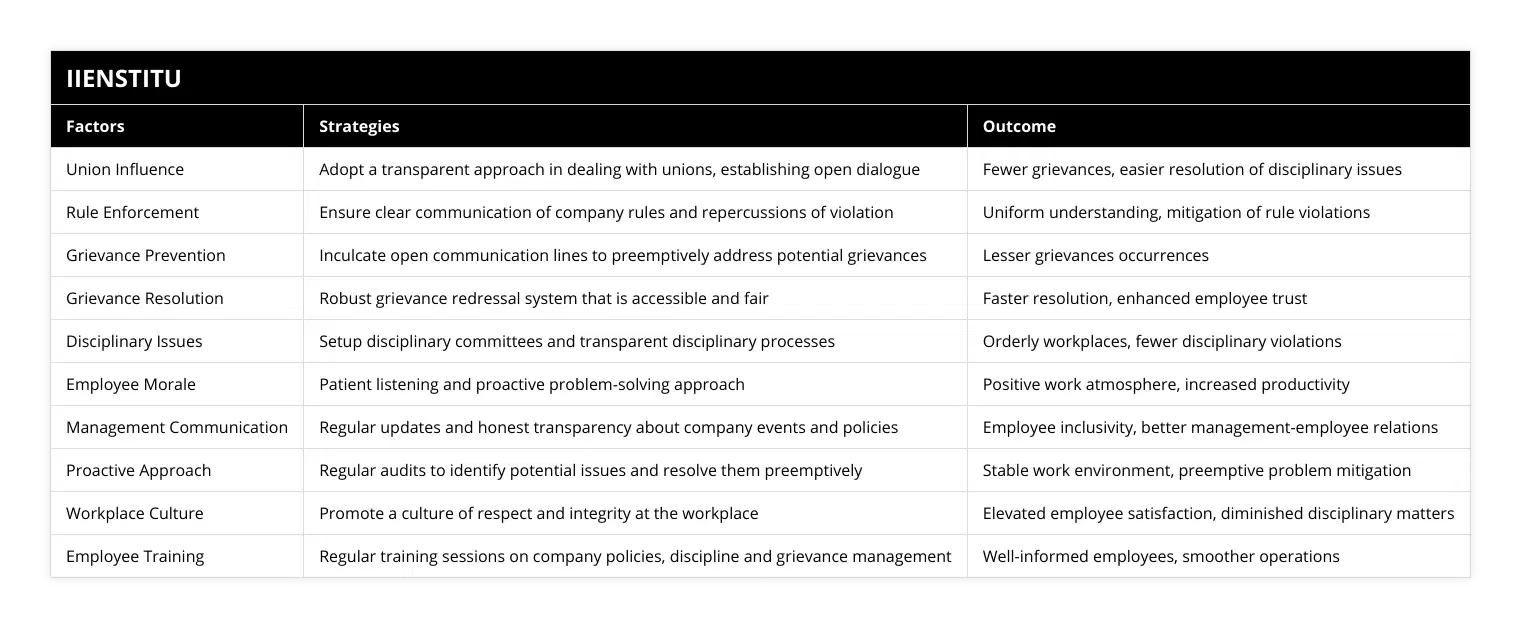
Frequently Asked Questions
What are the strategies for effective grievance and discipline management?
Effective grievance and discipline management strategies include establishing clear policies and procedures, investing in training, encouraging open communication, using a formal grievance process, and establishing an appeals process. These strategies will help to ensure that grievances are addressed quickly and appropriately and that disciplinary actions are applied consistently and fairly.

What strategies can large companies use to effectively manage grievances and discipline?
Large companies face unique challenges when it comes to effectively managing grievances and discipline. With many employees, it can be challenging to ensure that grievances are addressed promptly and effectively, and that discipline is applied consistently and fairly. To ensure that grievances and discipline are managed effectively, companies should consider implementing the following strategies:
Establish Clear Policies and Procedures: The first step in effective grievance and discipline management is establishing clear policies and procedures. All employees should be made aware of the policies and procedures and be given the opportunity to provide feedback. Companies should regularly review their policies and procedures to ensure they are up-to-date and effective.
Invest in Training: Companies should train managers and supervisors in grievance and discipline management. This will ensure that they have the skills and knowledge necessary to handle grievances and disciplinary issues promptly and appropriately.
Encourage Open Communication: Companies should strive to create an environment where employees feel comfortable speaking up about issues or concerns. Open communication will help to ensure grievances are addressed quickly and appropriately.
Use a Formal Grievance Process: Companies should establish a formal grievance process to ensure that grievances are addressed efficiently and effectively. The process should be communicated to all employees and provide a clear path for employees to follow if they have a grievance.
Establish an Appeals Process: Companies should also establish an appeals process for employees if they are not satisfied with the outcome of a grievance or disciplinary action. This will ensure that employees have a chance to have their grievances heard and addressed.
By implementing these strategies, companies can ensure that grievances and discipline management are handled effectively and fairly.
By investing in training, encouraging open communication, and establishing clear policies and procedures, companies can ensure that grievances are addressed promptly, and that discipline is applied consistently and fairly.
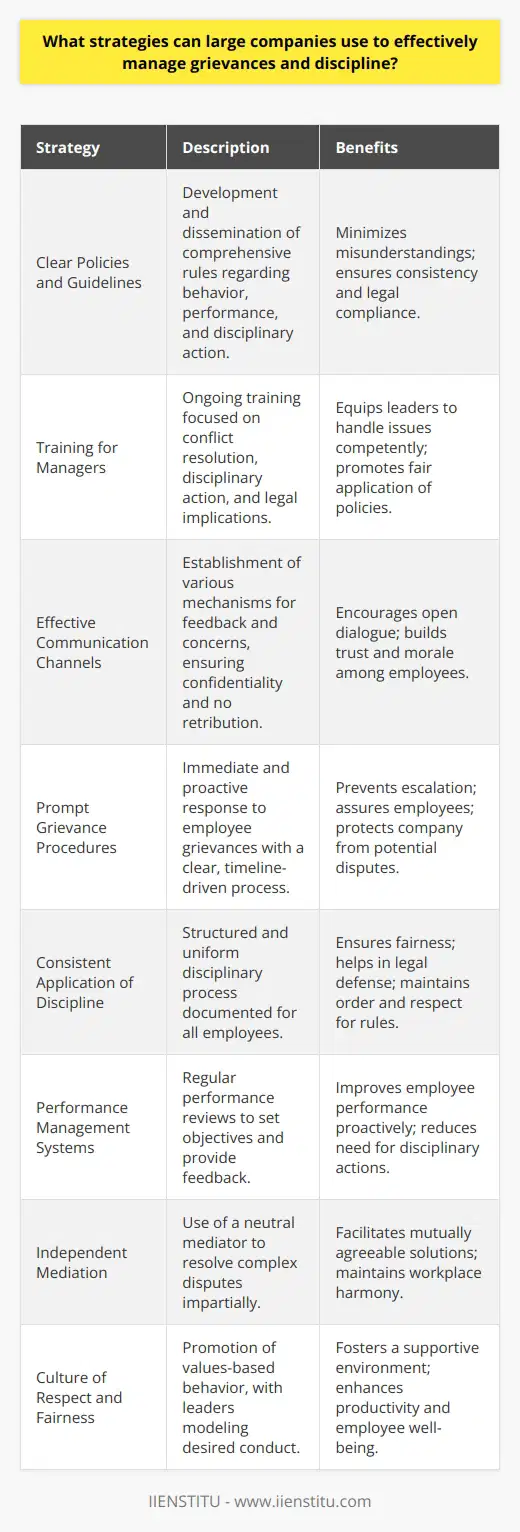
How can unions complicate the process of dealing with grievances and discipline in large companies?
Unions can complicate dealing with grievances and discipline in large companies. This is because blocks are often in conflict with employers regarding the resolution of grievances and disciplinary issues. Unions can challenge employers’ policies and procedures and their power to impose discipline and punishments.
Unions have the power to negotiate wages, hours, and other terms of employment. This means they can also arrange the process of dealing with grievances and discipline. However, this can create friction between the union and the employer, as the association may seek to protect the rights of its members and challenge the employer’s policies and procedures.
Unions also have the power to file grievances and bring legal action against employers. This can further complicate the process of dealing with grievances and discipline. Employers may face costly legal action if the union believes the employer violates a collective bargaining agreement or the law.
Unions also have the power to call for a strike if the employer does not satisfactorily address grievances or discipline. Again, this can disrupt the operations of a large company and lead to significant financial losses.
In addition, unions can use their influence to pressure employers to address grievances and discipline. This can be done through public campaigns or other forms of stress. However, this can complicate dealing with grievances and discipline in large companies.
Unions can also complicate dealing with grievances and discipline in large companies by demanding that employers comply with the terms of union contracts. Unions can challenge an employer’s decisions and policies if they believe they are unfair or violate the collective bargaining agreement.
In conclusion, unions can complicate the process of dealing with grievances and discipline in large companies due to their power to negotiate wages, hours, and other terms of employment, file grievances and bring legal action, call for a strike, and use their influence to pressure employers.

What is the HR department's major responsibility in matters of discipline?
HR Department's Role in Discipline
The Human Resources (HR) department plays a crucial role in an organization's disciplinary matters. One of their major responsibilities is to establish and implement consistent discipline policies and procedures, ensuring that the rules are transparent, equitable, and align with the organization's goals and values.
Policy Development and Implementation
HR professionals develop procedures to address employee misconduct and establish a fair disciplinary process, avoiding bias and favoritism. This involves understanding applicable laws, providing guidance on appropriate disciplinary actions, and identifying potential discrimination and retaliation.
Communication and Education
The HR department is responsible for effectively communicating disciplinary policies to employees and reinforcing disciplinary guidelines through regular training sessions. This ensures that employees understand the expected organizational standards and reduces the likelihood of disputes arising from misinterpretation of policies.
Investigation and Documentation
To maintain consistency and fairness, the HR department is often involved in investigating complaints and incidents related to employee misconduct. This includes gathering evidence, conducting interviews, coordinating with relevant parties, and ensuring proper documentation of every step of the process. Management of this crucial aspect helps build a solid foundation for any disciplinary actions taken.
Supporting Managers and Employees
HR professionals act as objective consultants for managers, advising them on the appropriate disciplinary actions while ensuring employees' rights are protected. By providing guidance, they ensure that disputes are resolved fairly and respectfully, fostering a harmonious work environment.
Monitoring and Continuous Improvement
Lastly, the HR department must continuously monitor disciplinary practices to identify trends, assess effectiveness, and make data-driven improvements to better serve the organization's needs. This process involves tracking disciplinary cases, employee feedback, and external best practices to optimize disciplinary policies and procedures.
In conclusion, the HR department's major responsibility in matters of discipline is to create and maintain a fair and systematic disciplinary process that helps employees adhere to expected behavioral standards, thus promoting a professional and positive work environment. Their involvement in policy development, communication, investigation, support, and continuous improvement is crucial in maintaining a successful organizational culture.
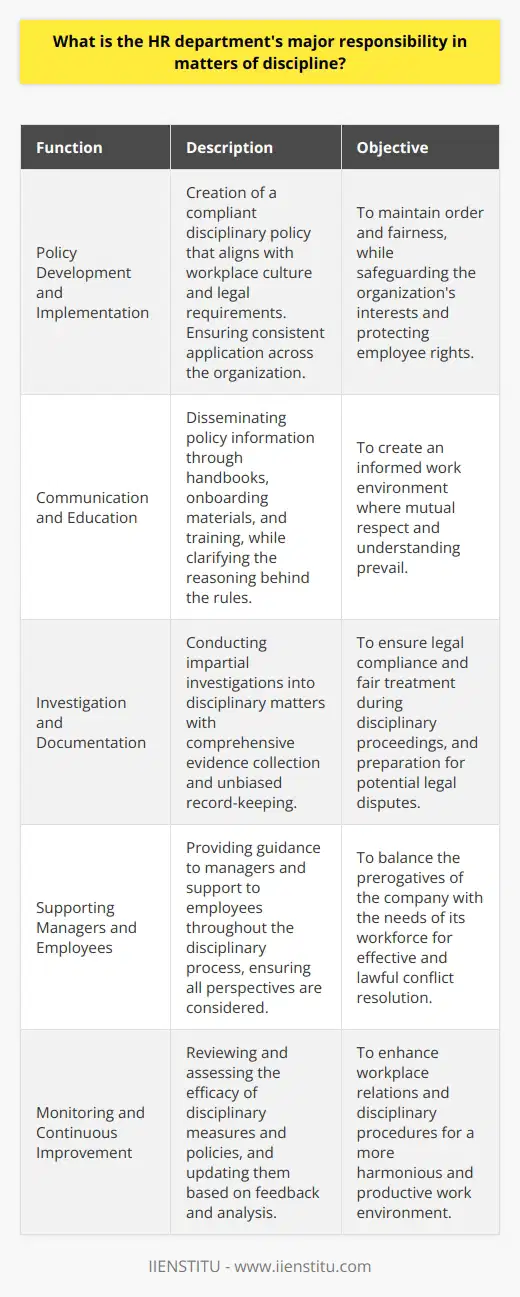
How does HR handle disciplinary actions within an organization?
**Roles and Responsibilities of HR**
Human Resource (HR) departments play a crucial role in handling disciplinary actions within an organization. They ensure that employees adhere to the company's policies, rules, and regulations while maintaining fairness and promoting a positive work environment. HR professionals are responsible for understanding and implementing disciplinary measures that are useful in managing employee performance and behavior effectively.
**Process of Disciplinary Actions**
To handle disciplinary actions, HR usually follows a structured process that begins with setting clear expectations about the acceptable workplace behavior. They achieve this by developing, communicating, and revising policies and procedures to ensure employees understand the code of conduct at work. The process includes identifying unacceptable behavior, issuing written or verbal warnings, and applying appropriate disciplinary actions, such as performance improvement plans, suspensions, or terminations. HR must also document each step in the disciplinary process to have a paper trail that supports their actions.
**Training and Support**
A significant aspect of handling disciplinary actions within an organization is training supervisors and managers on effective disciplinary and conflict resolution techniques. HR departments organize training sessions and provide support materials for managers to help them identify, address, and resolve disciplinary issues in the workplace. Additionally, HR supports employees by providing feedback mechanisms and assistance programs, which may involve counseling services, conflict resolution resources, or other support systems that could be beneficial for employees who require assistance.
**Legal Compliance**
HR also plays a role in ensuring that organizations comply with employment laws when it comes to disciplinary actions. Since disciplinary processes can potentially lead to employee terminations, it is crucial for HR to stay informed about the latest labor-related legislation and legal requirements in the organization's jurisdiction. HR must ensure that disciplinary actions do not discriminate against any employee based on protected characteristics, such as race, religion, or disability. This compliance helps organizations avoid lawsuits and claims related to wrongful termination or discrimination.
**Ensuring Fairness**
Lastly, HR professionals ensure that disciplinary actions are fair and consistent across the organization. They achieve this by developing standardized guidelines for disciplinary actions and maintaining open lines of communication with all involved parties. HR facilitates transparent and unbiased investigations into misconduct allegations, and they carefully weigh the evidence, considering both the employee's perspective and the organization's best interests before deciding on the appropriate disciplinary measures. This approach ensures that employees feel respected and treated fairly, and it fosters a work culture based on trust and accountability.
In conclusion, HR departments are entrusted with the responsibility of managing disciplinary actions within an organization. They ensure employees adhere to the code of conduct by developing policies, implementing disciplinary measures, providing training and support, ensuring legal compliance, and fostering fairness throughout the disciplinary process.
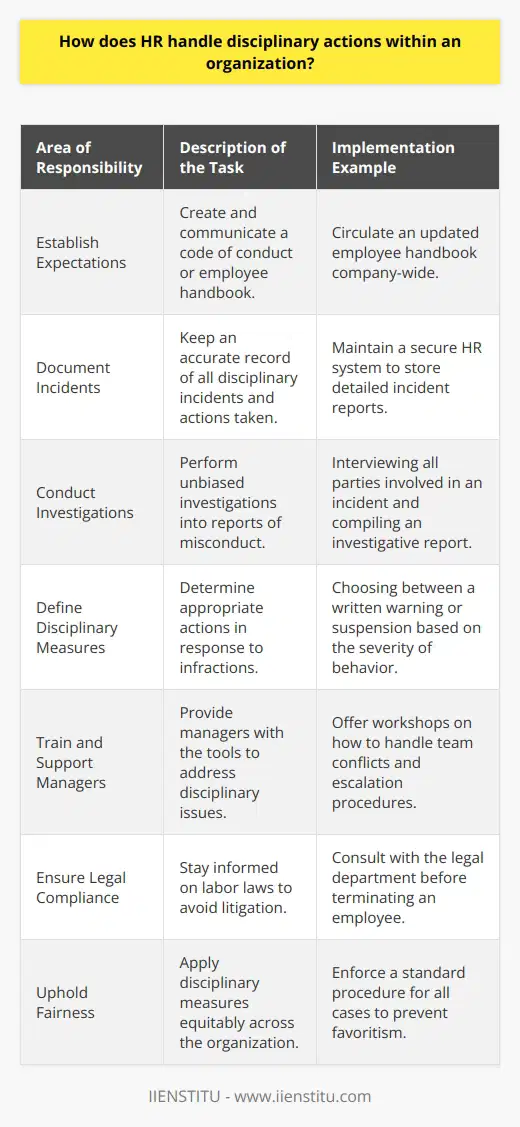
What role does HR play in disciplinary and grievance procedures?
Role of HR in Disciplinary Procedures
In an organizational setting, the Human Resources (HR) department plays a significant role in disciplinary and grievance procedures. HR professionals are responsible for ensuring that employees adhere to a company's policies, rules, regulations, and ethical standards. This involves establishing and maintaining fair and consistent processes to address misconduct, conflicts, complaints, and other workplace issues.
Developing and Implementing Policies
One of HR's primary functions is to develop and implement disciplinary and grievance policies that are transparent, impartial, and justifiable. These policies should be well-communicated to all employees, providing clear guidelines on acceptable behaviors and the consequences of violating them. Additionally, HR must ensure that supervisors and managers receive proper training to effectively enforce these policies and maintain a productive and harmonious work environment.
Investigating and Addressing Issues
HR handles the investigation of disciplinary and grievance cases, gathering relevant evidence, and conducting interviews with the involved parties. HR should collaborate with relevant stakeholders, such as management and legal advisors, in making an unbiased assessment of the circumstances. Based on the findings, HR recommends a suitable course of action, whether it involves mediation, disciplinary sanctions, or even termination of employment.
Ensuring Compliance with Regulations
HR must stay up-to-date with local, state, and federal employment laws while administering disciplinary and grievance procedures. This knowledge is essential to ensure that the organization complies with the respective regulations and avoids potential legal issues or financial penalties.
Supporting Employees during Grievances
HR also plays a crucial role in supporting employees during the grievance process, guiding them on how to raise concerns and present their cases. They should act as an impartial mediator between employees and the organization, ensuring that both sides are treated fairly and properly heard. In doing so, HR helps to cultivate a positive work culture that promotes trust and respect among employees.
Maintaining Confidentiality and Documentation
Throughout the entire disciplinary and grievance process, HR is responsible for maintaining confidentiality and ensuring that sensitive information is not disclosed inappropriately. Proper documentation must be kept to ensure a transparent system and serve as a reference for future disputes or performance evaluations.
In conclusion, the effective implementation of disciplinary and grievance procedures is central to HR's role in promoting a fair and harmonious work environment. By developing and enforcing policies, investigating issues, ensuring regulatory compliance, and supporting employees, HR helps to safeguard the organization's interests and cultivate a positive organizational culture.
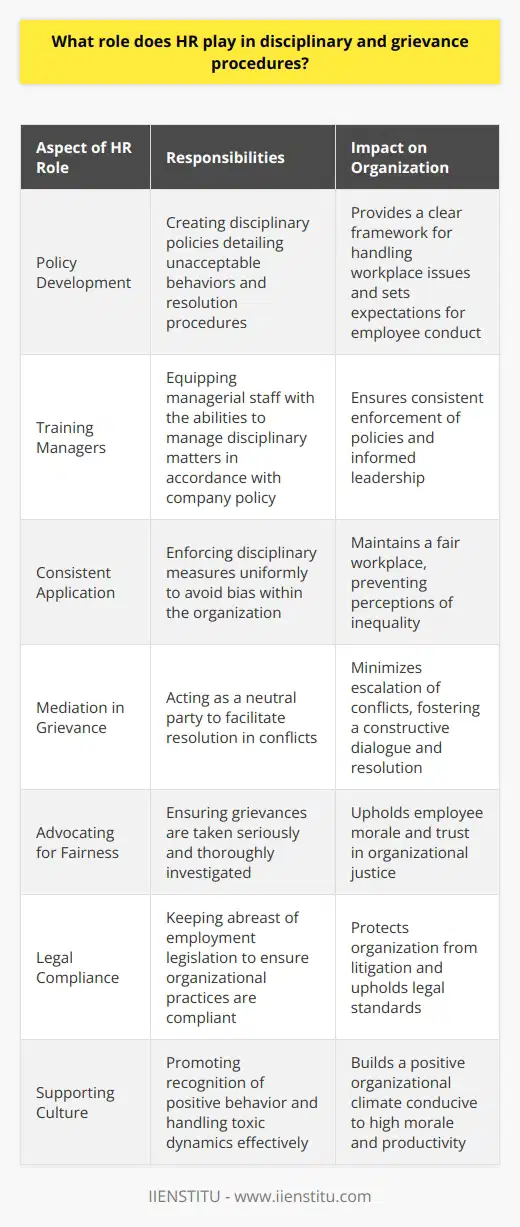
What is grievance management in HRM?
Understanding Grievance Management in HRM
Grievance management refers to the process through which employees express concerns or complaints, primarily related to their work conditions, treatment, or unfair practices. This process aims to address, resolve and prevent potential conflicts in the workplace and promote harmony among employees, thereby improving overall work dynamics.
Role of Human Resource Management (HRM)
HRM plays a vital role in grievance management, as it serves as a buffer between employees and management. They are responsible for designing and implementing effective and unbiased grievance management procedures, ensuring that complaints are appropriately addressed in a timely manner.
Steps in Grievance Management
Complaint Lodging: HRM should provide clear guidelines for lodging complaints, such as following an open-door policy, using a suggestion box or registering complaints through an online portal. Accessibility and confidentiality are key elements of this step.
Investigation and Review: HRM should conduct a thorough investigation of the grievance, gathering relevant facts and data, and considering the perspectives of all parties involved. The investigation must be impartial and in line with company policies.
Resolution and Communication: Once the investigation is complete, HRM should determine a resolution, which can range from counseling to corrective actions, such as policy updates, infrastructure improvements, or other measures. The resolution should be communicated to the concerned parties and documented for future reference.
Follow-up and Monitoring: It is essential to ensure that the solution is effectively implemented and monitored to prevent recurrence of the grievance. HRM might collaborate with line managers to oversee the execution of the corrective action plan.
Benefits of Effective Grievance Management
Proper grievance management can lead to numerous benefits for the organization, such as improved employee satisfaction, increased productivity, a healthier work environment, and reduced attrition rates. Furthermore, addressing grievances helps organizations comply with legal requirements and mitigate risks associated with potential lawsuits or labor disputes.
In conclusion, grievance management is an essential aspect of HRM, aimed at addressing employees' concerns and fostering a harmonious work environment. To achieve this, HRM must develop and maintain an effective and unbiased grievance process that includes lodging, investigation, resolution, and follow-up steps. Addressing grievances in a timely and constructive manner can contribute to creating a positive workplace, enhancing employee well-being, and improving overall organizational performance.
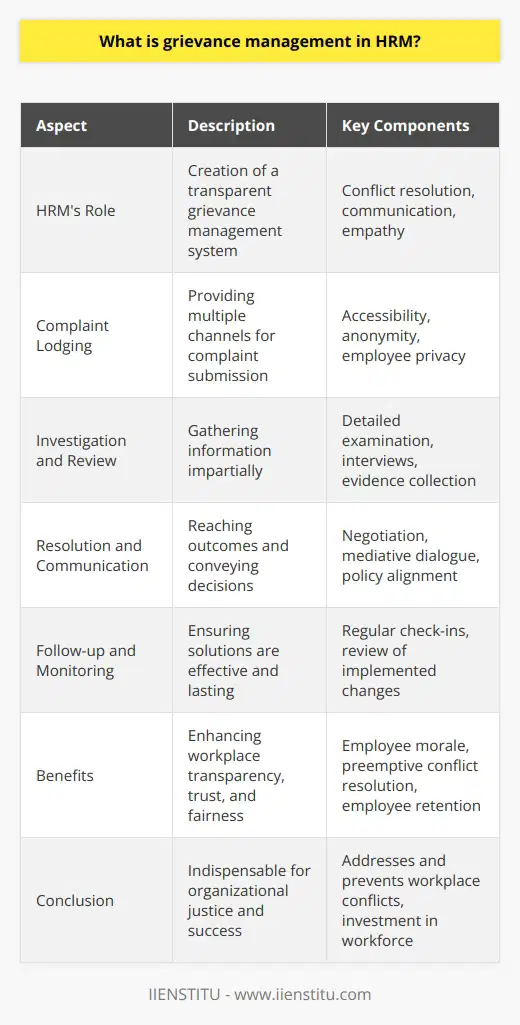
How do disciplinary and grievance procedures connect to overall HR strategy in organizations?
Disciplinary and Grievance Procedures as HR Strategy Components
Organizations need a strong human resource (HR) strategy to manage the performance, conduct, and overall well-being of their employees. Within this comprehensive approach, disciplinary and grievance procedures serve as essential components, aiming to maintain a fair, transparent, and orderly work environment. These procedures ensure the alignment of individual actions with organizational values, goals, and expectations while promoting a respectful and harmonious workplace culture.
Dealing with Employee Issues
Disciplinary procedures are often designed to correct employees' performance or behavior-related issues that deviate from the organization's norms and policies. Employers follow these structured processes to address the concerns systematically, issue warnings, provide support, and if necessary, impose sanctions. This promotes fairness, consistency, and adherence to legal requirements while minimizing the likelihood of tensions or conflicts among staff members.
Handling Employee Complaints
Grievance procedures, on the other hand, enable employees to raise their concerns, complaints, or disputes in a formal and systematic manner. This channel helps organizations address employee dissatisfaction or concerns, investigate their validity, and, if appropriate, resolve them through constructive dialogue or appropriate action. An effective grievance redressal system fosters employee trust, confidence, and loyalty to the organization, which is crucial for creating a positive work culture and retaining talented personnel.
Legal and Ethical Compliance
Both disciplinary and grievance procedures must abide by the legal and ethical obligations of the organization. Employers have to ensure nondiscrimination, the equitable treatment of employees, and compliance with relevant employment laws while implementing these procedures. Upholding legal and ethical standards not only safeguards the organization against potential lawsuits or regulatory penalties but also contributes to its corporate social responsibility and ethical reputation.
Linking to Organizational Goals
An organization's HR strategy should be aligned with its broader objectives and mission. By incorporating disciplinary and grievance procedures into the HR framework, organizations can foster a workplace environment that supports productivity, teamwork, diversity, and inclusion. Such a holistic HR approach enhances employees' commitment to achieving organizational goals, driving overall success, and maintaining a competitive edge in the market.
In conclusion, disciplinary and grievance procedures are crucial to an organization's HR strategy as they address performance and conduct-related issues, maintain a healthy work culture, and instill a sense of justice and fairness. Ensuring the legality and ethics of these processes further strengthens the organization's reputation and contributes to its overarching goals.
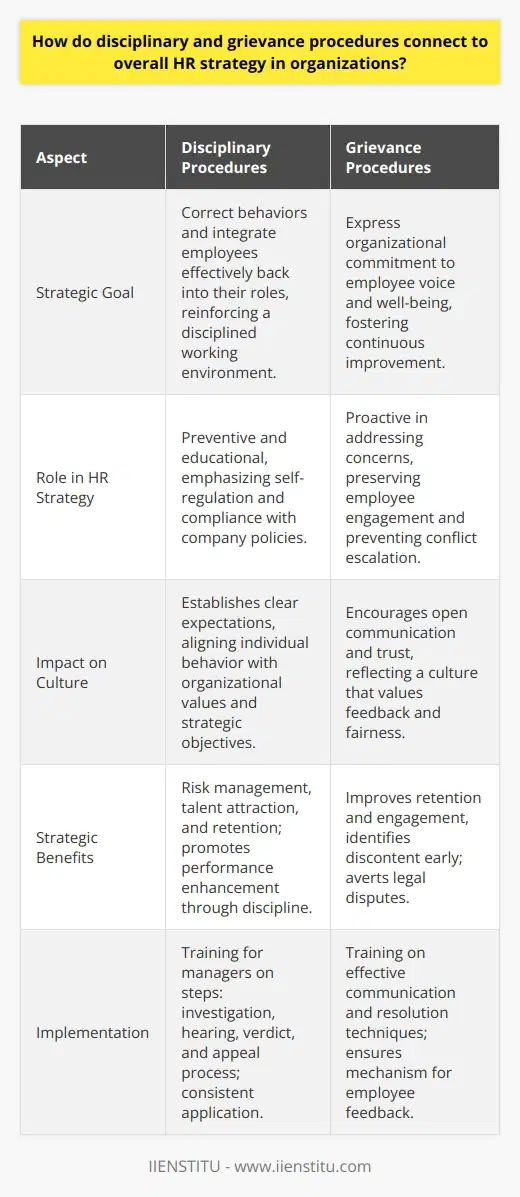
How can HR leaders ensure a fair and unbiased disciplinary process for employees?
Establishing Clear Policies
To ensure a fair and unbiased disciplinary process, HR leaders must first establish clear and comprehensive policies that apply to all employees. These guidelines should be outlined in the employee handbook and include violations, consequences, and procedures for reporting problems. Consistency in rules and expectations contributes to impartiality, fosters transparency, and communicates the organization's values to workers.
Training HR Professionals
Training is crucial to promote a fair and unbiased approach in disciplinary matters. HR leaders must participate in professional development programs that focus on impartiality, conflict resolution, and ethical decision-making. This education allows HR professionals to handle disciplinary issues effectively, avoiding personal biases that may influence the outcome.
Diverse Representation in Decision-Making
Including diverse perspectives in disciplinary decision-making processes is essential for avoiding implicit biases. HR leaders can promote objectivity by incorporating a variety of viewpoints from different backgrounds and gender. Collaboration between diverse team members enables a comprehensive analysis, ensuring a just solution for employees involved.
Timely and Transparent Communication
HR leaders should maintain open, transparent communication with employees throughout the disciplinary process. By providing updates at every stage and fostering an environment of trust, HR leaders can alleviate concerns about bias and unfair treatment. Regular and open communication is crucial for producing fair and unbiased solutions.
Recording and Documenting Incidents
To guarantee objectivity, HR leaders must document all disciplinary incidents, including complaints, evidence, and actions taken. Thorough documentation helps protect against biased decisions and allows the parties involved to evaluate the situation accurately. Moreover, robust records are necessary for legal compliance and minimizing liability risks.
Review and Evaluation of Disciplinary Actions
Finally, HR leaders can ensure an unbiased disciplinary process by reviewing past cases and evaluating the effectiveness of the company's disciplinary procedures. This analysis will disclose any patterns of discrimination or inequality and present an opportunity to refine policies and practices.
By implementing these practices, HR professionals can shape a work environment that fosters equality, impartiality, and fairness. Establishing clear policies, training HR personnel, encouraging diverse representation in decision-making, transparent communication, maintaining proper records, and reviewing previous cases will empower HR leaders to create an unbiased discipline process for all employees.
